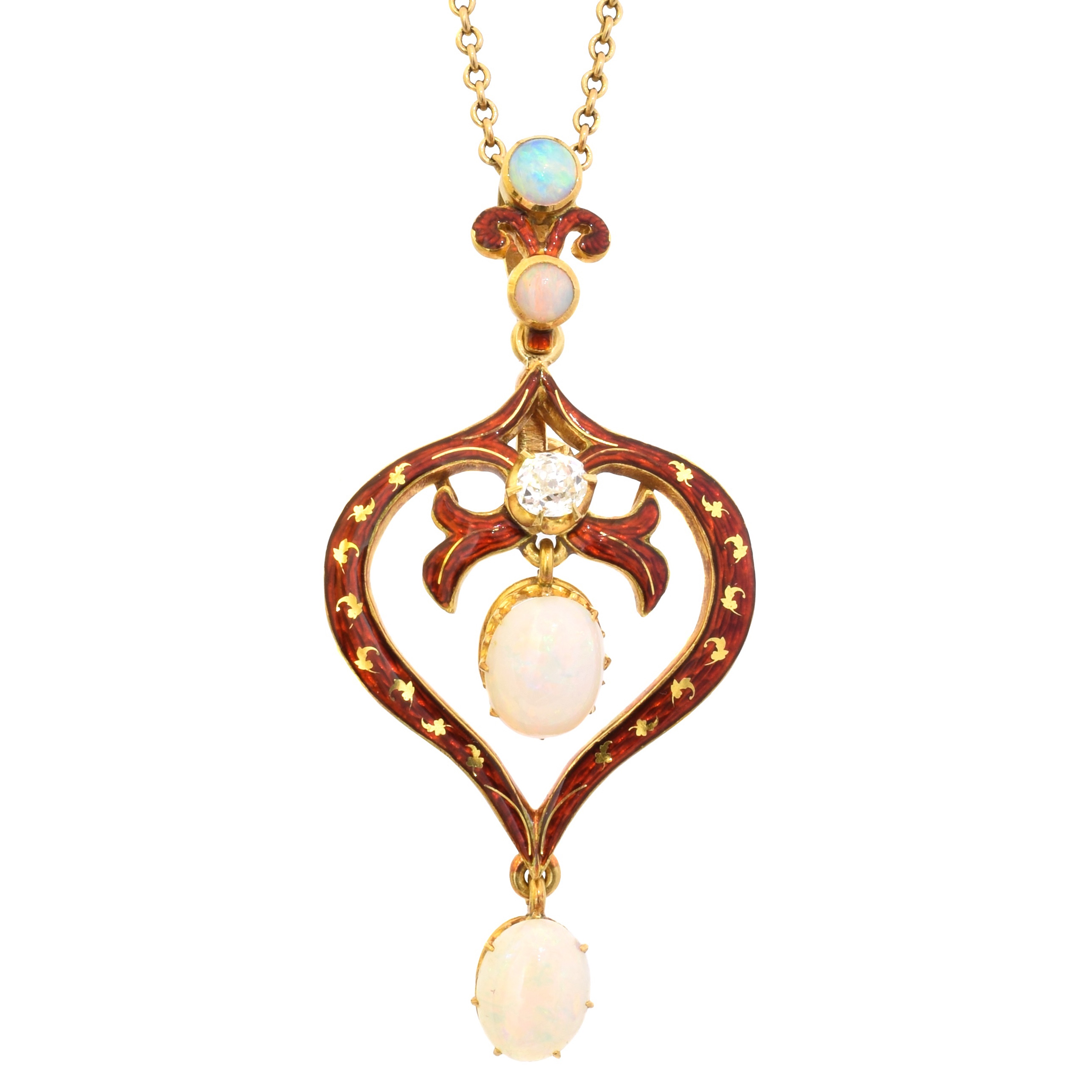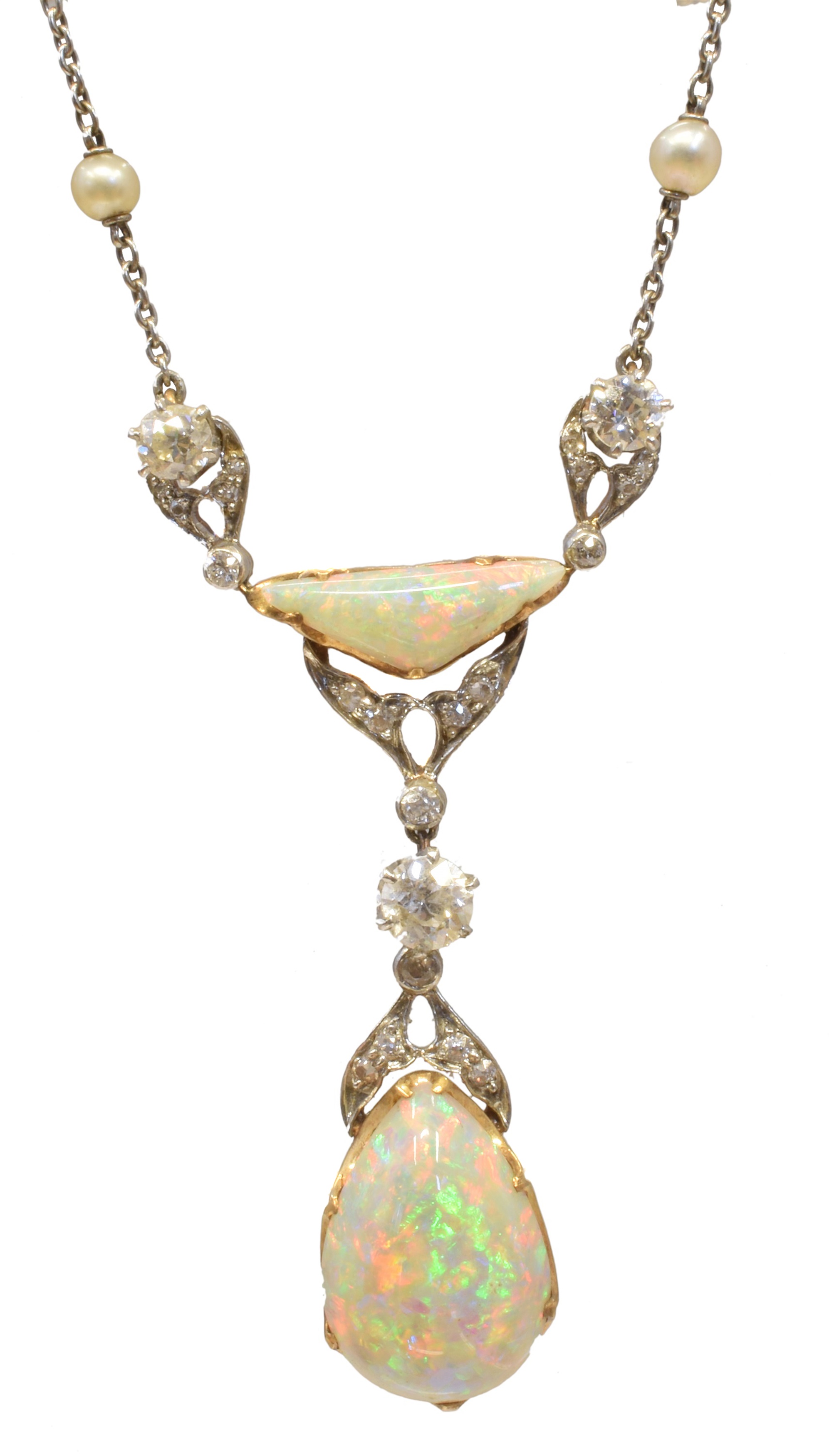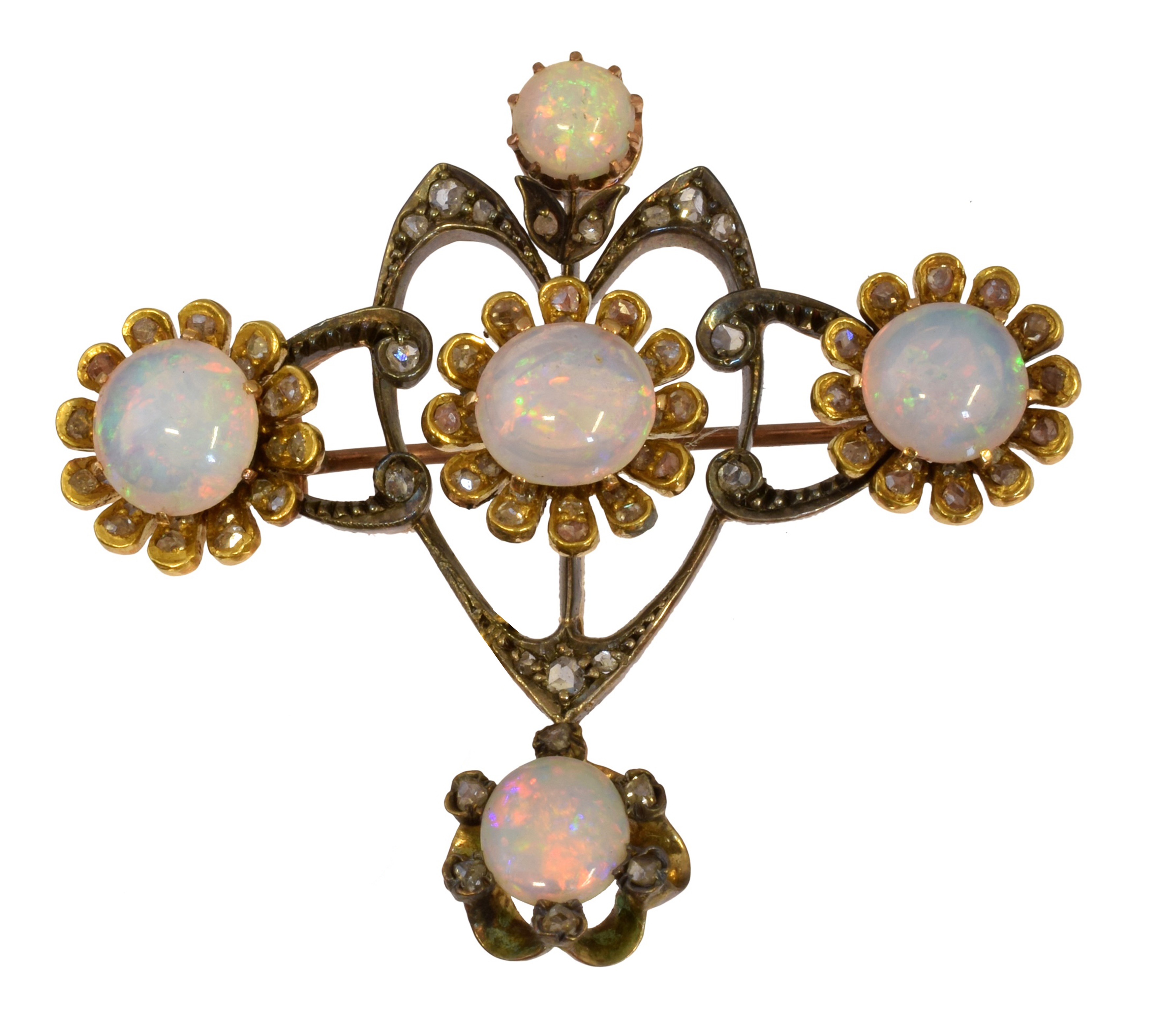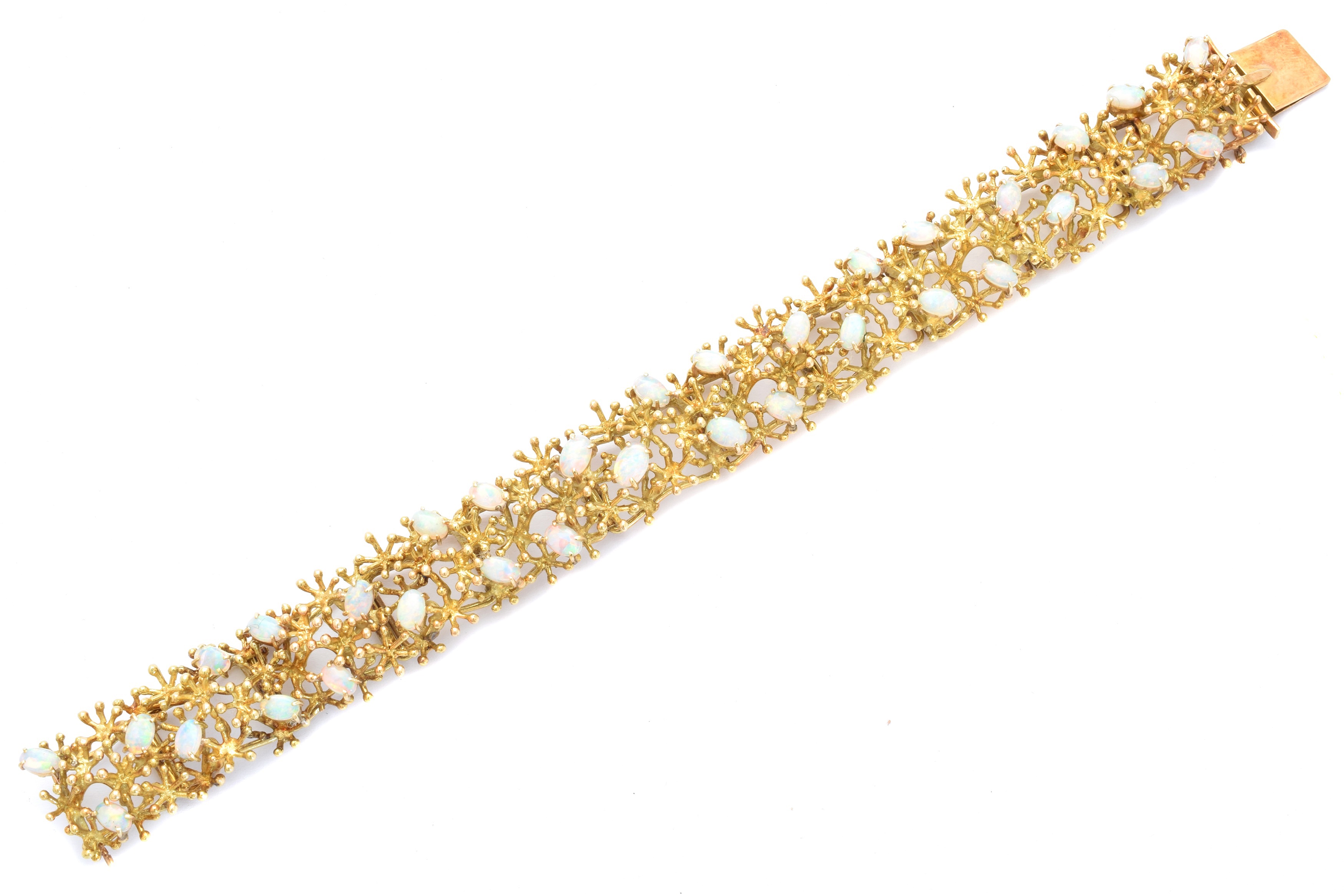October Birthstone - Opals
Spotlight On...
20th September 2021 | by Liz Bailey, Jewellery Specialist on behalf of Wilson55
“She wore no turban or headdress of any kind, saving a blue riband drawn through her auburn hair, and secured by a gold clasp…. ornamented by a superb opal, which, amid the changing lights peculiar to that gem, displayed internally a slight tinge of red like a spark of fire.”
Walter Scott, Anne of Geierstein
Opals are endlessly fascinating gemstones with unique kaleidoscopic optical properties and a unique history of superstition, folklore and celebration. First prized by the Romans, the opal was named from ‘Opalus’ which means ‘change in colour.’
Opals were believed to bring the wearer a wide range of talismanic properties, thought to “combine all the virtues of the various coloured gems, the hues of which are united in its sparkling light.” (George Frederick Kunz, The Curious Lore of Precious Stones, 1894)
The famous ‘play of colour’ seen in opals is produced by the diffraction of light through tightly packed silica spheres that make up the gemstone. Amorphous and randomly arranged in keeping with the growth conditions, each opal diffracts light differently, with varying colours, patterns and vibrancy.
Generally speaking, the brighter and more lively the play of colour, the more prized the opal is. Red tones are highly favoured amongst collectors, as this diffraction of the shortest wavelength of visible light is not as frequently seen as the blue and green flashes and indicates a tightly packed structure. The only exception to this rule is in the fire opal, a bright tangerine orange stone that is prized for its depth of orange body colour and not its fire.
19th Century

An early 20th century enamel opal and diamond pendant by Mrs Newman. Sold for £1,952.
The superstition that opals are unlucky became prevalent in the early 19th century. It is likely that this association with misfortune emerged following Sir Walter Scott’s novel Anne of Geierstein, in which the protagonist Lady Hermione wears a wonderful opal in her hair. Indeed, the opal is described to reflect the mood of the main character and ultimately, plays a part in her downfall. After a few drops of holy water, the colours of the opal fade and poor Hermione turns to ashes!
Queen Victoria however did her best to dispel the superstitions surrounding opals, and gifted opal jewellery to her peers in large quantities. Opals set in yellow gold and accented with enamel and diamonds in the form of crescent brooches, hinged bangles, star brooches, and cluster rings became popular following Victoria’s example.
The famous black opals of Lightning Ridge came onto the market in the 1880s, the amazing flashes of vibrant colour contrasting beautifully off a darker background were a world apart from the milky, white and jelly opals previously sourced mostly from the Czech Republic.
Early 20th Century

An early 20th century opal, diamond and seed pearl necklace. Sold for £1,830.
The stunning combination of opals and diamonds was hugely popular in late 19th and lent itself brilliantly to early 20th century jewellery. The emergence of platinum as the metal de jour at this time complemented these gemstones beautifully and enabled finer settings to showcase larger and often more brightly coloured opals. During this time, opal cabochons carved in heart, pear, triangular and other fancy shapes formed the centrepiece of the jewel, with diamond accents throughout.
Arts & Crafts

An Arts & Crafts opal and vari gem brooch attributed to Arthur and Georgie Gaskin. Sold for £793.
To the Arts & Crafts jewellers, “opals were a natural choice, both white ones and the clear fire opals of Mexico” (Hinks, 1975). Opals of all forms, shapes and colour patterns are seen in Arts & Crafts jewels, with the makers of the movement favouring inexpensive gemstones for their beautifully made jewels. The versatility of the opal group, with body colours ranging from milky white, to bright blue, dramatic black and vibrant tangerine, as well as the availability of the gemstones at the time meant that they were certainly the gemstone of choice for most of the Arts & Crafts jewellers. The colours seen in opals very much complemented the enamelwork of the Arts & Crafts jewellers, the two seen in renderings of peacocks, ships, floral garlands, and medieval scenes.
A husband-and-wife jeweller duo to use opals in their work were the Gaskins. Set frequently in silver, alongside paste and blister pearls, the work of Birmingham-based Arthur & Georgie Gaskin really showcases the unique optical properties of the opal to great effect. Their naturally inspired designs favour the natural patterns and colour flashes of the opal, drawing their pieces together beautifully.
Art Nouveau
In a similar vein, opals worked superbly in Art Nouveau jewellery, favoured for their ethereal appearance in rendering these naturalistic, sinuous, and romantic designs. A firm favourite of Lalique, his pieces included opals carved in foliate designs, used in a plique-à-jour style settings, as well as faceted fire opals in some beautiful horn jewellery which can be seen in the Victoria & Albert Museum.

An Art Nouveau opal and diamond brooch retailed by Wartski. Sold for £732.
1960s/1970s
Once again in favour with a visionary group of jewellers and designers, the opal fell back into favour in 1960s and 70s jewellery. With the likes of Andrew Grima, John Donald, George Weil, Arthur King celebrating the colours, vibrancy and earthy qualities of the natural opal in their work featuring all types of opal set in bold, experimental, and textured gold pieces that were not designed for the shy and retiring!
During this time, opal composites also became popular, with the advent of opal doublets, triplets and ‘mosaic opal’ frequently seen. Opal doublets and triplets are thin slices of opal backed or sandwiched between layers of a dark background and colourless quartz or glass top to enhance the appearance of the stone. Similarly, ‘mosaic opal’ contains pieces of opal crystal arranged and backed in the same way. These composites can be easily detected depending on the setting, clear layers can be seen if a side or back view of the stone is possible.
Synthetic opals were also first commercially available in 1975, and so feature in general jewellery of this time. Synthetic opals are detectable by their ‘lizard skin’ patterns which appear columnar when viewed obliquely, noticeably different from their randomly arranged and amorphous natural counterparts.

A 1960s opal bracelet. Sold for £1,037.
Watch Out! Care of Opal Jewellery
As with all gemstones, there are factors to consider when examining opal jewellery. Opals firstly are incredibly soft gemstones, and sensitive to changes in their environment. Pieces with cracks and crazing can be significantly devalued so good care of opal jewellery is essential.
- Store pieces in a separate compartment from other jewels to minimise scratching, and do not wear for gardening, housework, or any other endeavours in which pieces are likely to be knocked!
- Never clean opal jewellery in an ultrasonic cleaner, as the vibrations will cause the stone to crack.
- Store opals away from extreme sources of heat or cold, ideally store pieces in a cloth pouch. If you are storing for a long time, to prevent the opal dehydrating, place it in cotton wool with a few drops of water and into a sealed bag.
- Apply perfumes well before putting opal jewellery on, as these stones can be very sensitive to erosion.
To gain a free auction valuation of your jewellery, and to find out about entering your items into a Fine Jewellery Auction, contact our specialist Liz Bailey MA FGA DGA CPAA via liz.bailey@wilson55.com
